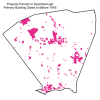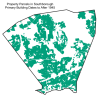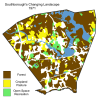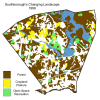[Ed note: My Southborough accepts signed letters to the editor submitted by Southborough residents. Letters may be emailed to mysouthborough@gmail.com.
The following letter is from James Nichols-Worley.]
To the Editor:
Last Tuesday, at a Public Forum covering two 40B applications for multi-unit developments at 120 and 250 Turnpike Road, I encouraged the Select Board to be supportive in its comments to MassHousing, the state authority that oversees 40B applications. I want to elaborate on my public comment in favor of the two projects and also draw attention to a double-standard between multi-unit developments and Southborough’s current housing stock of mainly single-family homes.
A brief explanation of 40B: to “address the shortage of affordable housing statewide” the relevant section of the law simplifies the planning process for new developments in communities under the 10% threshold of affordable housing stock–Southborough is just under 8%. Four years before 40B’s passage in 1969, Martin Luther King delivered a speech to the Massachusetts Legislature: “We see subtle forms of discrimination in all of our communities, expressed in housing discrimination… In a real sense [it is] segregation, whether it is de jure segregation of certain sections of the South or de facto segregation of the North…”
I do not want to draw too much attention to the specific projects or even the 40B process itself, but rather how this situation illustrates a larger issue. I can not nor do I wish to speak on behalf of the developer–all opinions expressed here are my own–although in my view they are a reputable firm. I use the site at 250 Turnpike as a topical example and may simplify some aspects of the project.
As I predicted during my public comment, all of the other comments focused on the negative aspects of the development. New development will increase the absolute traffic flow on abutting roads. Large developments create a demand shock to our school system because state funding lags behind population growth. Others, mainly abutters, rightfully commented that new construction may be visible from their property and potentially affect water drainage in the area, although the degree of both claims was disputed at the Forum.
Despite these facts, I urged the Select Board to continue its support of the projects because there are also benefits that come from these developments–positive aspects that are often ignored–that outweigh these concerns. While the Select Board finalized its letter, the process for these developments is only just beginning.
Multi-unit buildings have fewer cars per person than single-family homes and duplexes. Because Southborough has an absolute quota on the amount of affordable units it needs to construct to meet the 10% affordable housing threshold, those concerned with the impact on local traffic and roads should be supportive of multi-unit affordable development, because it will result in fewer total cars. Both developments also have quick access to I-495, I-90, Route 85 and the MBTA Commuter Rail Station.
New developments are obviously more energy efficient than older buildings because they make use of the most up-to-date technology, materials, and construction techniques. Multi-unit buildings are also more energy efficient than single-family homes. (Ferris Development has also indicated that there is potential for solar panels on one or both of the buildings.) Again, it’s important to remember that Southborough has a state-imposed quota of affordable construction. Spreading these units across smaller developments will be less climate-friendly and more environmentally destructive.
I am sympathetic to the previously reported claims of abutters on Parkerville Road, Sarsenstone Way, and Skylar Drive concerning “potential clear cutting of the wooded parcel.” However, I think their analysis misses the forest for the trees, and here is where the double-standard towards different types of development can be found. We are far harsher on the potential negative impacts of one multi-unit building than we are on the combined impact of multiple single-family homes.

The best example of this is land usage.* In 1945, only 758 acres of land in town were used for buildings and developed parcels. With a population of 2,496, this means Southborough’s average developed lot supported 3.3 people per acre, concentrated in our historic villages of Southborough Center, Cordaville, Fayville, and Southville.
 After 1945, Southborough experienced increasing suburban sprawl. Today, developed lots occupy over 9,935 acres in town, and yet our population has increased only to 10,450. Our newly developed land is far less dense. The average lot now supports only 1.1 people per acre.
After 1945, Southborough experienced increasing suburban sprawl. Today, developed lots occupy over 9,935 acres in town, and yet our population has increased only to 10,450. Our newly developed land is far less dense. The average lot now supports only 1.1 people per acre.
The impact on Southborough’s landscape is unmistakable. Land coverage data shows significant damage to our forests and farmland between 1971 and 1999.
Had we retained the “character” of our construction in 1945, we could have either preserved Southborough’s natural resources or increased our population to over 32,000, yet we chose to cut down forests while using land less efficiently.
Despite such environmental degradation, our declared objections to development are apparently well-known. It’s evident from Boston Globe headlines like “Southborough: A quiet town trying to stay that way.”
 However, that article is not covering recent developments. The article is from 1985, and evidently arguments against new development have not changed much since then. If we applied the same standard used today against the properties abutting 250 Turnpike Road, would they have ever been built after 1985?
However, that article is not covering recent developments. The article is from 1985, and evidently arguments against new development have not changed much since then. If we applied the same standard used today against the properties abutting 250 Turnpike Road, would they have ever been built after 1985?
I doubt the single-family homes near the proposed site received nearly the same opposition, such as threats of legal action or dilatory proposals. Surely the construction of these homes involved cutting down trees, restructuring local drainage, the pavement of new roads and driveways, and were arguably “out of character” for the development of the town at the time. The modern subdivision would be unimaginable to Southborough’s past rural character.
And yet, because each home is a smaller project than the newly proposed building, each one attracted less opposition than maybe they should have faced collectively. Consider if the new apartment building already existed–the abutters’ claims about how it might affect them would be just as true as before the project is completed. Yet we would not consider the possibility of tearing down the building and evicting over 50 families on the chance it might improve the neighborhood character.
Unfortunately, our future residents have no voice in this matter. 8,000 of us today are surely thankful enough homes were built after 1945. For our entire history Southborough has grown, outwards and upwards. There is little to suggest that 2023 is the year where we should calcify our development and become an open air museum. I like to believe that our town’s character has more to do with the people who live in our community rather than the size of our buildings, and I am confident I do not hold this opinion alone. “You can very quickly become one of us,” longtime Southborough resident Jane Campbell told the Globe in 1985.
We must be wary of the double-standards that cloud our judgment. All development involves tradeoffs, and we’d be wrongheaded to ignore the positive aspects of a project. If, as a town, we care about environmental impacts, increased traffic, and yes, even affordable housing in one of the most expensive communities in Central Massachusetts, we should be supportive of multi-family housing. When we look at the crises of housing affordability, homelessness, and temporarily sheltering families, they are all intertwined in our chronic underproduction of housing. Southborough is not an island: any progress we make in producing more market rate and affordable housing will ensure our senior citizens can continue to live in our community; that those starting new families can move back; and that we can make our region affordable for those who share our values, who add to our prosperity, and as Governor Healey put it: “it’s important that we, as a state, market that and be clear to other parts of the country that, right now, have residents and citizens there who are experiencing the curtailing of certain freedoms.”
In 1977, the Supreme Judicial Court of Massachusetts decided whether Southborough could abdocate its responsibilities elsewhere. They answered with a forceful no:
Southborough [can not] justify its own exclusionary rule by saying that [one] might overcome it by going elsewhere in the Commonwealth. May a “fundamental” right be denied in Worcester County because it remains available in Suffolk or Barnstable? Such a proposition cannot be seriously maintained. The picture of one community attempting thus to throw off on others would not be a happy one.
The negative consequences of new developments are often highly localized. We should respect these opinions and consider them with great weight. In theory, our democratic town government should be responsive to all opinions. However, our growth should not be governed only by objections, but should be a balance of all interests, especially of those who can’t voice their opinion at Town Hall. It’s clear to me that these new developments would not only expand on our housing goals, as outlined in the 2021 Master Plan, but would also significantly improve our town’s character and reputation. I look forward to supporting similar developments in the future, when they inevitably arise.
As the Reverend Doctor King told the Legislature, “Now is the time for men of goodwill to get together to make it possible for better housing conditions to be brought into being for low-income and middle-income families.” Let us make good on that commitment by supporting smart growth and eliminating the barriers blocking our new neighbors.
James Nichols-Worley
94 Main Street
* This analysis, informed by publicly available tax records, is based on a great article in CommonWealth magazine by Garrett Nelson, president and head curator at the Leventhal Map & Education Center at the Boston Public Library. All maps are my own.




Please provide your analysis on the impact to the School budget. Also, please provide your analysis on the overall financial impact to the town. How will that impact affect our elderly? What other programs will require sacrifices as a result? Will property values be impacted?
There are always two sides. Using “virtue” to justify your position while ignoring the potential negative impacts to the other side of the argument will rarely result in a moral good.
Tim, thank you for your questions. I can’t speak any more specifically on the recently proposed sites on Route 9, but I hope I can provide my perspective on multi-unit and affordable housing more generally.
“Please provide your analysis on the impact to the School budget.”
As I understand Chapter 40B and the Comprehensive Permitting Process, there is a minimum number of housing units that Southborough needs to create. Whether this occurs in a building with 50 units, two buildings with 25 each, or spread out among many more buildings, the impact of delaying the construction seems marginal. 40B is like the hydra, where new projects spring up when we cut the wrong ones down. There is a minimum number of units we need to build.
Off the top of my head, I can think of several reasons why this is not a concern related to specifically to multi-unit buildings: the addition of single bedroom units means there will be fewer families than the equivalent amount of single-family homes; demographics in Massachusetts and America mean residents are, on average, getting older and having fewer kids, so direct comparisons to past development will overestimate the demand shock to the school system; and finally, some accounts indicate that “increased [school] costs are occurring in communities with declining enrollments as well as increasing enrollments.”
At the same time, enrollment in Southborough schools has been steadily declining for a decade: 1,333 enrolled 2013-2014, with only 1,180 enrolled 2022-2023. State reimbursements will catch up with the student population in town. However, we have seen examples where sustained student population loss has resulted in significant cuts to the school system. In Marblehead, where the population aged 25-44 shrank 63% in the 2010s, a precarious town meeting override failed, resulting in the loss of 30 positions in the school system. Our school system has grown before. It might be difficult, but it is preferable to manage growth rather than manage decline.
“Also, please provide your analysis on the overall financial impact to the town.”
Obviously this depends on a case-by-case analysis of projects, but in general, multi-unit developments “have the same fiscal impact as the vast majority of their neighbors.”
There are some long-term, practical reasons why multi-unit buildings are preferable to single-family homes. Although I am not an expert on municipal taxation, it is my understanding that there are several ways that single-family homeowners can defer property taxes. This is obviously a good program for homeowners who might not otherwise be expected to pay based on their income. However, in terms of municipal taxation, multi-unit buildings could bring in more steady sources of revenue for the town’s budget on a per-person basis. Based on a brief analysis from MassLandlords, “a non-profit for owners and managers of Massachusetts residential real estate,” rental properties in Massachusetts can even be taxed at a different rate than owner-occupied residential properties. However, Southborough notably has a flat tax rate between Residential, Commercial, and Industrial property.
A 2016 analysis of a 63-unit building in Sudbury found it would “have an estimated annual revenue stream of $989,000 and an estimated annual service cost of $700,000.” Obviously, such a development can have a positive fiscal impact on the town! Again, I cannot confidently forecast any specific site, but it is possible to do correctly.
How will that impact affect our elderly?
Based on what I have written above, I don’t believe new multi-unit developments will necessarily have a negative fiscal impact on the town, based on similar developments and comprehensive studies of the issue, and may even provide more revenue than they use in town resources.
However, I can imagine plenty of ways new multi-unit development will benefit our elderly neighbors. The Globe reports that “many older residents in Massachusetts who’d like to downsize — and turn over spacious dwellings to younger buyers desperate for room to expand —are finding it difficult, if not impossible. Even though their property values have ballooned, smaller homes or condos are scarce and carry prohibitive price tags in the state’s out-of-kilter real estate market.” In my opinion, new zoning measures like allowing Accessory Dwelling Units by right would also help this issue, but surely expanding the options we have would only benefit whoever is interested. The 2021 Master Plan, as I indicated, lays out this goal for the town: to “Create strategies to offer more diversity in housing, encouraging alternatives to large single-family houses that would allow young professionals/families to reside in Southborough and seniors to stay in town.” Additionally, we can imagine plenty of second-order benefits: for example, by diversifying the housing stock in town and creating new multi-unit developments in town could let more families move back to Southborough to live near their parents or grandparents.
What other programs will require sacrifices as a result?
Again, based on the previous two answers, I don’t necessarily believe that we will need to “sacrifice” any programs, or that the quality of service will decline in any area. In fact, with a new pool of residents, we will have more people to volunteer for our town committees and help in all aspects of our civic, social, and cultural institutions.
Will property values be impacted?
This question I can answer with the most confidence: “No, Large Apartment Buildings Won’t Devalue Your Home.” To continue, “The negative perception of the risk associated with the building of apartments is dominant, even if negated by research and surveys. Once apartments are constructed and inhabited, negative attitudes about them usually subside.” This is one of the most common concerns about new multi-unit development, and yet there is not yet conclusive empirical evidence supporting it. If multi-unit developments are indeed fiscally beneficial as I have stated above, the gains can be used to provide increased services for town residents. Southborough’s excellent public schools are one of the reasons our town is so desirable (and our housing so expensive).
There are always two sides. Using “virtue” to justify your position while ignoring the potential negative impacts to the other side of the argument will rarely result in a moral good.
At the most recent Planning Board meeting, I explained why I am perturbed by the “argument” about development, and why I believe there is a double-standard between single-family development and multi-unit development. I will try to elaborate on those comments in writing.
Concerns about development are very useful on a case-by-case basis. For example, Freddie Gillespie, a member of the Stewardship Committee and Open Space Preservation Commission, laid out well-researched concerns about the adjacent conservation land and other issues near a proposed development at 120 Turnpike Road at several recent board meetings. I am not too familiar with this specific site, but I admit these could be very good reasons to change the scope of the project there! From what I have seen, the Planning Board, other town committees, and various advocates, do a tremendous job at evaluating individual projects, and I believe we will be well served if they keep their steady course.
However, it is the effect in aggregate across hundreds of proposed sites, of all legal, environmental, and traffic concerns being used to block new projects. I want to see new affordable housing and new multi-unit housing constructed in Southborough, mainly for the reasons listed in the Letter above, and I see any issues concerning specific sites as problems that can be solved in pursuit of that goal. In my opinion, there is a now 80-year-old pattern, not just in Massachusetts, but in America, of using concerns to delay, prevent, and block instead of improve and create. No specific iteration of the Planning Board, no neighborhood, and no developer is at fault, but there has clearly been a preference in Southborough towards spreading out rather than building up, a preference that I think we have miscalculated. The debate about multi-unit housing is very skewed away from the most generally raised objections concerning height, size, and character, towards other, site-specific concerns. As I said, we live in a world of tradeoffs. There is never going to be a “perfect” opportunity for development, but we need to actually weigh the positives against the negatives.
This is why I include the Supreme Judicial Court’s response in Framingham Clinic, Inc. vs. Board of Selectmen of Southborough. Despite the fact that: after town meeting amended the zoning of restricted buildings in town from gold mines, junk yards, and fur farms to include abortion clinics; was sued by a prospective clinic; lost in the SJC; and even the Select Board, in the 1977 Annual Report, “decided that a further appeal of the case to the U.S. Supreme Court was not practical;” the town won, because the building that would have rented to the clinic by that point had chosen another tenant. Even if every objection is proven wrong or addressed, dilatory action can have significant consequences, especially financial, for a building developer. It is, in essence, a way of chasing a project out of town by wasting their time.
I don’t believe that I ignore “potential negative impacts,” as I laid several of them out in the fourth paragraph of the Letter and have just now addressed several more. My thesis is that, very rarely, does anyone advocate for these positive aspects, and additionally that, as a society, we are biased towards considering negative aspects more seriously than positive aspects.
As for using “virtue” to “justify [my] position,” besides the fact that I have laid out several quantitative economic benefits of multi-unit housing, in addition to the severe damage of deforestation and loss of agriculture in town caused by single-family subdivisions, I think it is wrongheaded to ignore our shared values when discussing development. Many advocates against multi-unit development frequently use “virtues” and moral characterizations, especially about “neighborhood character,” in discussions surrounding development. I do not think it is unfair to respond that “neighborhood character” should also be weighed against the other moral standards we hold ourselves to. Southborough is not building skyscrapers, but we can look to our neighbors, especially Hudson, who have shown that building up some sections of town can greatly benefit lower-density areas.
At the end of the day, I think Southborough is one of the best places in Massachusetts. We can help create opportunities for more folks to move in while retaining and improving what makes our town so great.